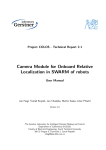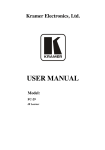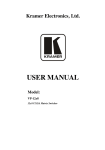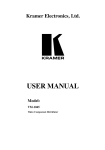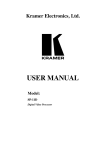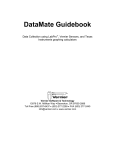Download USER MANUAL
Transcript
Kramer Electronics, Ltd. USER MANUAL Model: FC-6801 SDI De-Embedder Contents Contents 1 2 3 Introduction Getting Started Overview Controlling your FC-6801 Achieving the Best Performance 2 2 4 5 Your SDI De-Embedder Using Your FC-6801 SDI De-Embedder Connecting the FC-6801 SDI De-Embedder 2 5 5 5.1.1 5.1.2 5.1.3 Connecting a PC Setting the AUDIO DELAY Dipswitches Cascading FC-6801 SDI De-Embedder Units 6 6 8 5.2 Operating the FC-6801 SDI De-Embedder 10 6 7 Technical Specifications Communication Protocol 10 11 3.1 3.2 5.1 1 1 1 Figures Figure 1: FC-6801 SDI De-Embedder Figure 2: Connecting a FC-6801 Unit to a PC without using a Null-modem Adapter Figure 3: Connecting an FC-6801 SDI De-Embedder Figure 4: Cascading FC-6801 SDI De-Embedder Units 3 6 7 9 Tables Table 1: Front Panel FC-6801 SDI De-Embedder Table 2: Rear Panel FC FC-6801 SDI De-Embedder Table 3: AUDIO DELAY Dipswitch Settings Table 4: Setting the AUDIO DELAY Control Time Table 5: Technical Specifications of the FC-6801 SDI De-Embedder Table 6: Hex Code Commands Table 7: AUDIO DELAY Settings 4 4 6 6 10 11 12 i Introduction 1 Introduction Welcome to Kramer Electronics (since 1981): a world of unique, creative and affordable solutions to the infinite range of problems that confront the video, audio and presentation professional on a daily basis. In recent years, we have redesigned and upgraded most of our line, making the best even better! Our 350-plus different models now appear in 8 Groups1, which are clearly defined by function. Congratulations on purchasing your FC-6801 SDI De-Embedder, which is ideal for broadcast and production studios, as well as digital / analog audio video authoring. The package includes the following items: FC-6801 SDI De-Embedder Power cord Null-modem adapter and Windows®-based Kramer control software2 This user manual3 and the Kramer concise product catalog/CD 2 Getting Started We recommend that you: Unpack the equipment carefully and save the original box and packaging materials for possible future shipment Review the contents of this user manual Use Kramer high performance high resolution cables4 3 Overview The FC-6801 is a high quality audio de-embedder for serial digital video. It accepts a standard definition SDI source (270MHz), has an equalized (up to 350m automatic cable equalization) and reclocked SDI output (loop), and de-embeds the audio from the SDI stream. 1 GROUP 1: Distribution Amplifiers; GROUP 2: Video and Audio Switchers, Matrix Switchers and Controllers; GROUP 3: Video, Audio, VGA/XGA Processors; GROUP 4: Interfaces and Sync Processors; GROUP 5: Twisted Pair Interfaces; GROUP 6: Accessories and Rack Adapters; GROUP 7: Scan Converters and Scalers; and GROUP 8: Cables and Connectors 2 Downloadable from our Web site at http://www.kramerelectronics.com (click “DOS and Windows®-based software drivers for Kramer machines” in the Technical Support section) 3 Download up-to-date Kramer user manuals from the Internet at this URL: http://www.kramerelectronics.com/manuals.html 4 The complete list of Kramer cables is on our Web site at http://www.kramerelectronics.com (click “Cables and Connectors” in the Products section) 1 Your SDI De-Embedder In addition, the FC-6801: De-embeds four audio channels Provides de-embedded audio in both analog (balanced on XLR connectors) and digital (AES/EBU on BNC connectors) audio formats Includes automatic selection for 20/24 bit digital audio stream Includes a selectable audio delay of up to one second that lets you adjust for lip sync errors so that the audio delay will match the video delay1 Includes auto-detect 525/625 line format and EDH insertion and generation Has an embedded SDI input with active, reclocked and equalized output (loop) Can be cascaded to de-embed up to 16 channels Fits in one vertical space of a standard 19” professional rack enclosure 3.1 Controlling your FC-6801 The FC-6801 can be controlled via a user-friendly RS-232 Windows®-based Kramer control software2, which lets you recall group setup and the audio delay setting. Hardware control is via the rear panel AUDIO DELAY dipswitches, as well as via the front panel: GROUP SELECT button, that lets you select the audio group that you want to de-embed (the active audio channel LEDs light) Potentiometers that let you control the gain level of the analog output pairs Set of status LEDs, that indicate the bit resolution (20 or 24), the video input standard (PAL or NTSC), Video LOCK and Audio (DEMUX) LOCK 3.2 Achieving the Best Performance To achieve the best performance: Connect only good quality connection cables, thus avoiding interference, deterioration in signal quality due to poor matching, and elevated noise levels (often associated with low quality cables) Avoid interference from neighboring electrical appliances that may adversely influence signal quality and position your Kramer FC-6801 away from moisture, excessive sunlight and dust 4 Your SDI De-Embedder Figure 1, Table 1, and Table 2 define the FC-6801: 1 Total delay per AES channel is 1.024 seconds in 8 msec steps (8 msec x 128 = 1.024 seconds) 2 Downloadable from our Web site at http://www.kramerelectronics.com (click “DOS and Windows®-based software drivers for Kramer machines” in the Technical Support section) 2 KRAMER: SIMPLE CREATIVE TECHNOLOGY Your SDI De-Embedder Figure 1: FC-6801 SDI De-Embedder 3 Your SDI De-Embedder Table 1: Front Panel FC-6801 SDI De-Embedder Feature Function POWER Switch GROUP SELECT Button CHANNEL Green LEDs GROUP Green LEDs 24 bit Red LED 20 bit Red LED DEMUX Red LED Illuminated switch supplying power to the unit 1 Press to select the desired group 2 Automatically indicate the active channels Indicate the selected group (1, 2, 3, or 4) Automatically lights when the AES/EBU stream is 24 bit Automatically lights when the AES/EBU stream is 20 bit 8 9 10 11 12 LOCK # 1 2 3 4 5 6 7 VIDEO Red LED PAL Red LED NTSC Red LED GAIN 1-2 Knob GAIN 3-4 Knob Automatically lights when de-embedding audio from the video signal Automatically lights when receiving an SDI signal Lights when recognizing a PAL input video standard Lights when recognizing an NTSC input video standard Adjusts the gain level of the analog outputs 1 and 2 Adjusts the gain level of the analog outputs 3 and 4 Table 2: Rear Panel FC FC-6801 SDI De-Embedder Feature LOOP BNC Connector 2 3 4 5 INPUT BNC Connector OUT 1 BNC Connector OUT 2 BNC Connector AUDIO DELAY Dipswitches CH. 1-2 BNC Connector CH. 3-4 BNC Connector ANALOG AUDIO OUT XLR Male Connectors 9 RS-232 Port 10 Power Connector with Fuse AES OUT 6 7 8 SDI # 1 Function Reclocked and equalized SDI output for active looping of the SDI input3 Connects to the SDI source Connects to the SDI4 acceptor 15 Connects to the SDI4 acceptor 25 Dipswitches for setup of the delay time6 DIPS 1 to 7 determine the delay DIP 8 determines if audio delay is set via RS-232 (ON) or via the dipswitches (OFF) Connects to the digital audio acceptor (for channels 1 and 2)7 Connects to the digital audio acceptor (for channels 3 and 4)7 Connect to the balanced audio acceptors (from 1 to 4)5 Connects to the PC or the Remote Controller AC connector enabling power supply to the unit 1 If the selected group contains audio channels, the CHANNEL Green LEDs will automatically indicate those channels 2 Either 2 LEDs, 4 LEDs, or no LEDs will light 3 See the example in Figure 4 4 De-embedded, reclocked and equalized SDI output 5 As required. Outputs may be connected or left unconnected 6 Total delay per AES channel is 1.024 seconds in 8 msec steps (8 msec x 128 = 1.024 seconds) 7 In accordance with the standard, the audio digital stream contains 2 audio channels 4 KRAMER: SIMPLE CREATIVE TECHNOLOGY Using Your FC-6801 SDI De-Embedder 5 Using Your FC-6801 SDI De-Embedder Sections 5.1 and 5.2 describe how to connect and operate your FC-6801 SDI De-Embedder. 5.1 Connecting the FC-6801 SDI De-Embedder To connect the FC-6801 SDI De-Embedder, as the example in Figure 3 illustrates, do the following1: 1. Connect an SDI source (for example, a digital video player) to the SDI INPUT BNC connector. 2. Connect the SDI LOOP BNC connector (OPTIONAL) to the SDI INPUT BNC connector on an additional unit to increase outputs (see the illustration in Figure 4 which shows how to cascade four FC-6801 units). 3. Connect both SDI outputs to SDI acceptors as follows (when only one SDI output is required, use either of the SDI outputs, and leave the other SDI output unconnected): Connect the SDI OUT 1 BNC connector to an SDI acceptor (for example, SDI monitor 1) Connect the SDI OUT 2 BNC connector to the second SDI acceptor (for example, SDI monitor 2) 4. Connect the AES OUT channel 1-2 BNC connector2 to a digital audio acceptor for channels 1 and 2 (for example, DAT-Recorder A) 5. Connect the AES OUT channel 3-4 BNC connector2 to a digital audio acceptor for channels 3 and 4 (for example, DAT-Recorder B) 6. Connect up to 4 analog audio outputs to analog balanced audio acceptors, as required. Outputs may be connected3 or left unconnected. 7. Connect a PC (optional - see section 5.1.1) or other RS-232 controller. 8. Connect the power cord4. 1 Switch OFF the power on each device before connecting it to your FC-6801. After connecting your FC-6801, switch on its power and then switch on the power on each device. Switching on the FC-6801, recalls the last status prior to powering down 2 When only one digital audio stream containing 2 audio channels is required, use either of the AES outputs, and leave the other AES output unconnected 3 For example, connect the channel 1 and channel 2 OUT XLR connectors to a balanced stereo analog audio acceptor (amplifier 1), and connect the channel 3 and channel 4 OUT XLR connectors to a balanced stereo analog audio acceptor (amplifier 2) 4 The power connector is not illustrated in Figure 3 5 Using Your FC-6801 SDI De-Embedder 5.1.1 Connecting a PC To connect a PC to the FC-6801 unit, using the Null-modem adapter provided with the machine (recommended): Connect the RS-232 DB9 rear panel port on the FC-6801 unit to the Null-modem adapter and connect the Null-modem adapter with a 9 wire flat cable to the RS-232 DB9 port on your PC To connect a PC to the FC-6801 unit, without using a Null-modem adapter: Connect the RS-232 DB9 port on your PC to the RS-232 DB9 rear panel port on the FC-6801 unit, as Figure 2 illustrates (depending on whether the PC has a 9-pin or 25-pin connector) Figure 2: Connecting a FC-6801 Unit to a PC without using a Null-modem Adapter 5.1.2 Setting the AUDIO DELAY Dipswitches Table 3 defines the AUDIO DELAY dipswitch settings: Table 3: AUDIO DELAY Dipswitch Settings DIPS Description 1 to 7 Delay setting 8 Operation via PC (or other controller) = ON; Operation via DIPS 1 to 7 = OFF Table 4 includes examples of how to set DIPS 1 to 7: Table 4: Setting the AUDIO DELAY Control Time msec 8 40 80 160 400 800 1024 6 Binary Value 1 101 1010 10100 110010 1100100 1111111 Increment DIP 1 DIP 2 DIP 3 DIP 4 DIP 5 DIP 6 DIP 7 1 5 10 20 50 100 128 ON ON ON ON ON OFF ON ON ON ON ON OFF OFF ON ON ON ON OFF OFF ON ON ON ON OFF ON ON ON ON ON OFF ON OFF ON OFF ON ON ON OFF ON OFF ON ON OFF OFF ON ON ON ON ON KRAMER: SIMPLE CREATIVE TECHNOLOGY Using Your FC-6801 SDI De-Embedder The example in Figure 3 illustrates how to connect the FC-6801: Figure 3: Connecting an FC-6801 SDI De-Embedder 7 Using Your FC-6801 SDI De-Embedder 5.1.3 Cascading FC-6801 SDI De-Embedder Units To cascade up to four FC-6801 SDI De-Embedder units, as the example in Figure 4 illustrates, do the following1: 1. Connect an SDI source (for example, a digital video player) to the SDI INPUT BNC connector on FC-6801 unit # 1 and interconnect the four FC-6801 units: Connect the SDI LOOP BNC connector on unit # 1 to the SDI INPUT BNC connector on unit # 2 Connect the SDI LOOP BNC connector on unit # 2 to the SDI INPUT BNC connector on unit # 3 Connect the SDI LOOP BNC connector on unit # 3 to the SDI INPUT BNC connector on unit # 4 2. Connect the two AES OUT BNC connectors on each of the four FC-6801 units to eight digital audio acceptors (a total of 16 channels): Connect the AES OUT channel 1-2 BNC connector on unit # 1 to an AES acceptor A (channels 1 and 2), and connect the AES OUT channel 3-4 BNC connector on unit # 1 to an AES acceptor B (channels 3 and 4) Connect the AES OUT BNC connectors on unit # 2 to an AES acceptor C (channels 5 and 6), and to an AES acceptor D (channels 7 and 8) Connect the AES OUT BNC connectors on unit # 3 to an AES acceptor E (channels 9 and 10), and to an AES acceptor F (channels 11 and 12) Connect the AES OUT BNC connectors on unit # 4 to an AES acceptor G (channels 13 and 14), and to an AES acceptor H (channels 15 and 16) 3. Connect the four analog audio OUT XLR connectors on each of the four FC-6801 units to 16 analog balanced audio acceptors: Connect the XLR connectors on unit # 1 to balanced audio acceptors 1 to 4 Connect the XLR connectors on unit # 2 to balanced audio acceptors 5 to 8 Connect the XLR connectors on unit # 3 to balanced audio acceptors 9 to 12 Connect the XLR connectors on unit # 4 to balanced audio acceptors 13 to 16 4. Connect the SDI outputs (OPTIONAL) on each of the four FC-6801 units to up to two SDI acceptors (eight in total)2. 5. Connect the power cord on each of the four FC-6801 units2. 1 Switch OFF the power on each device before connecting it to an FC-6801 unit. After connecting each FC-6801 unit, switch on its power and then switch on the power on each device 2 Not illustrated in Figure 4 8 KRAMER: SIMPLE CREATIVE TECHNOLOGY Using Your FC-6801 SDI De-Embedder Figure 4: Cascading FC-6801 SDI De-Embedder Units 9 Technical Specifications 5.2 Operating the FC-6801 SDI De-Embedder To operate the FC-6801 SDI De-Embedder: 1. Set the audio delay, via the: AUDIO DELAY dipswitches (see section 5.1.2); and/or Windows®-based Kramer control software1 2. Adjust the gain level of the balanced analog audio outputs, if required, via the: GAIN 1-2 knob2, and/or the GAIN 3-4 knob3; and/or Windows®-based Kramer control software1 6 Technical Specifications Table 5 includes the technical specifications: 4 Table 5: Technical Specifications of the FC-6801 SDI De-Embedder INPUT: OUTPUTS: 1 x SDI with embedded audio on BNC connector 2 x SDI on BNC connectors with EDH 1 x SDI reclocked Loop output 2 x AES-EBU on BNC connectors 4 x balanced audio on XLR connectors MAX. OUTPUT LEVEL: 7Vpp BANDWIDTH (-3dB): 20Hz – 20kHz S/N RATIO: –90dB CONTROLS: Analog audio level control, Delay settings, Group Select COUPLING: DC AUDIO THD + NOISE: 0.014% AUDIO 2nd HARMONIC: –90dB POWER SOURCE: 90-260VAC 50-60Hz 18VA DIMENSIONS: 19 inch (W), 7 inch (D), 1U (H) rack mountable WEIGHT: 2.5 kg (5.5 lbs) approx. ACCESSORIES: Power cord, Null-modem adapter and Windows®-based Kramer control software5 1 Downloadable from our Web site at http://www.kramerelectronics.com (click “DOS and Windows®-based software drivers for Kramer machines” in the Technical Support section) 2 Rotate to adjust the gain level of the balanced analog audio outputs 1 and 2 3 Rotate to adjust the gain level of the balanced analog audio outputs 3 and 4 4 Specifications are subject to change without notice 5 Downloadable from our Web site at http://www.kramerelectronics.com (click “DOS and Windows®-based software drivers for Kramer machines” in the Technical Support section) 10 KRAMER: SIMPLE CREATIVE TECHNOLOGY Communication Protocol 7 Communication Protocol The FC-6801 is compatible with Kramer’s Protocol 20001 (version 0.43). This RS-232 / RS-485 communication protocol uses four bytes of information as defined below. For RS-232, a null-modem connection between the machine and controller is used. The default data rate is 9600 baud, with no parity, 8 data bits and 1 stop bit. Table 6 defines the Hex Code commands and Table 7 lists the Hex Codes for the AUDIO DELAY settings. Table 6: Hex Code Commands Command Name Reset Factory default Identify machine Sw rev Group select Set delay Read led's Read delay Hex Send 00 80 80 92 00 81 80 92 3D 81 81 92 3D 83 80 92 01 8GR 80 92 02 DL 80 92 05 80 80 92 06 80 80 92 Hex Receive 40 80 80 92 40 81 80 92 7D E8 81 92 7D 8R1 8R2 92 41 8GR 80 92 42 DL 80 92 45 LED1 LED2 92 46 DL 80 92 Function Reset the machine Set machine to factory default Software revision Audio group select Set audio delay time Read the LED's status Read the delay settings NOTES on the above table: NOTES on the above table: NOTE 1 - R1 – Sw revision number. NOTE 2 - R2 – Sw sub revision number. NOTE 3 - GR – audio group number: 0 mute 1 group 1 2 group 2 3 group 3 4 group 4 NOTE 4 - DL – delay time: The MSB (bit(7)) should be ' 1' Bits [6..0] set the delay time in steps of 8ms To set no delay send "10000000" To set a delay of 8ms send "10000001" To set a delay of 16ms send "10000010" To set delay of 1.024 sec, send "11111111" To send any value in the middle, use the appropriate number NOTE 5 - LED1 – reply of the status of the following: The MSB (bit(7)) will be ' 1' Bits [6..4] – audio group: 0 mute 1 group 1 2 group 2 3 group 3 4 group 4 bits[3..0] – Audio channel status – ' 1'on, ' 0'off bit(3) channel 4 bit(2) channel 3 bit(1) channel 2 bit(0) channel 1 NOTE 6 - LED2 – Video & audio status Bits[7..4] are "1000" Bit(3) when audio is detected in the video stream this bit will be ' 1'else ' 0' Bit(2) when video is detected this bit will be ' 1'else it will be ' 0' Bit(1) video standard ' 0'for PAL, ' 1'for NTSC Bit(0) if 24 bit of audio is detected ' 1' , else ' 0' 1 See the Technical Support section of our Web site: http://www.kramerelectronics.com 11 Communication Protocol Table 7: AUDIO DELAY Settings Decimal Hex Codes Delay Time (in ms) Decimal Hex Codes Delay Time (in ms) Decimal Hex Codes Delay Time (in ms) 1 01 8 44 2C 352 87 57 696 2 02 16 45 2D 360 88 58 704 3 03 24 46 2E 368 89 59 712 4 04 32 47 2F 376 90 5A 720 5 05 40 48 30 384 91 5B 728 6 06 48 49 31 392 92 5C 736 7 07 56 50 32 400 93 5D 744 8 08 64 51 33 408 94 5E 752 9 09 72 52 34 416 95 5F 760 10 0A 80 53 35 424 96 60 768 11 0B 88 54 36 432 97 61 776 12 0C 96 55 37 440 98 62 784 13 0D 104 56 38 448 99 63 792 14 0E 112 57 39 456 100 64 800 15 0F 120 58 3A 464 101 65 808 16 10 128 59 3B 472 102 66 816 17 11 136 60 3C 480 103 67 824 18 12 144 61 3D 488 104 68 832 19 13 152 62 3E 496 105 69 840 20 14 160 63 3F 504 106 6A 848 21 15 168 64 40 512 107 6B 856 22 16 176 65 41 520 108 6C 864 23 17 184 66 42 528 109 6D 872 24 18 192 67 43 536 110 6E 880 25 19 200 68 44 544 111 6F 888 26 1A 208 69 45 552 112 70 896 27 1B 216 70 46 560 113 71 904 28 1C 224 71 47 568 114 72 912 29 1D 232 72 48 576 115 73 920 30 1E 240 73 49 584 116 74 928 31 1F 248 74 4A 592 117 75 936 32 20 256 75 4B 600 118 76 944 33 21 264 76 4C 608 119 77 952 34 22 272 77 4D 616 120 78 960 35 23 280 78 4E 624 121 78 968 36 24 288 79 4F 632 122 7A 976 37 25 296 80 50 640 123 7B 984 38 26 304 81 51 648 124 7C 992 39 27 312 82 52 656 125 7D 1000 40 28 320 83 53 664 126 7E 1008 41 29 328 84 54 672 127 7F 1016 42 2A 336 85 55 680 43 2B 344 86 56 688 12 KRAMER: SIMPLE CREATIVE TECHNOLOGY LIMITED WARRANTY Kramer Electronics (hereafter Kramer) warrants this product free from defects in material and workmanship under the following terms. HOW LONG IS THE WARRANTY Labor and parts are warranted for three years from the date of the first customer purchase. WHO IS PROTECTED? Only the first purchase customer may enforce this warranty. WHAT IS COVERED AND WHAT IS NOT COVERED Except as below, this warranty covers all defects in material or workmanship in this product. The following are not covered by the warranty: 1. 2. 3. Any product which is not distributed by Kramer, or which is not purchased from an authorized Kramer dealer. If you are uncertain as to whether a dealer is authorized, please contact Kramer at one of the agents listed in the web site www.kramerelectronics.com. Any product, on which the serial number has been defaced, modified or removed. Damage, deterioration or malfunction resulting from: i) Accident, misuse, abuse, neglect, fire, water, lightning or other acts of nature ii) Product modification, or failure to follow instructions supplied with the product iii) Repair or attempted repair by anyone not authorized by Kramer iv) Any shipment of the product (claims must be presented to the carrier) v) Removal or installation of the product vi) Any other cause, which does not relate to a product defect vii) Cartons, equipment enclosures, cables or accessories used in conjunction with the product WHAT WE WILL PAY FOR AND WHAT WE WILL NOT PAY FOR We will pay labor and material expenses for covered items. We will not pay for the following: 1. 2. 3. Removal or installations charges. Costs of initial technical adjustments (set-up), including adjustment of user controls or programming. These costs are the responsibility of the Kramer dealer from whom the product was purchased. Shipping charges. HOW YOU CAN GET WARRANTY SERVICE 1. 2. 3. To obtain service on you product, you must take or ship it prepaid to any authorized Kramer service center. Whenever warranty service is required, the original dated invoice (or a copy) must be presented as proof of warranty coverage, and should be included in any shipment of the product. Please also include in any mailing a contact name, company, address, and a description of the problem(s). For the name of the nearest Kramer authorized service center, consult your authorized dealer. LIMITATION OF IMPLIED WARRANTIES All implied warranties, including warranties of merchantability and fitness for a particular purpose, are limited in duration to the length of this warranty. EXCLUSION OF DAMAGES The liability of Kramer for any effective products is limited to the repair or replacement of the product at our option. Kramer shall not be liable for: 1. 2. Damage to other property caused by defects in this product, damages based upon inconvenience, loss of use of the product, loss of time, commercial loss; or: Any other damages, whether incidental, consequential or otherwise. Some countries may not allow limitations on how long an implied warranty lasts and/or do not allow the exclusion or limitation of incidental or consequential damages, so the above limitations and exclusions may not apply to you. This warranty gives you specific legal rights, and you may also have other rights, which vary from place to place. NOTE: All products returned to Kramer for service must have prior approval. This may be obtained from your dealer. This equipment has been tested to determine compliance with the requirements of: EN-50081: "Electromagnetic compatibility (EMC); generic emission standard. Part 1: Residential, commercial and light industry" EN-50082: "Electromagnetic compatibility (EMC) generic immunity standard. Part 1: Residential, commercial and light industry environment". CFR-47: FCC Rules and Regulations: Part 15: “Radio frequency devices Subpart B – Unintentional radiators” CAUTION! Servicing the machines can only be done by an authorized Kramer technician. Any user who makes changes or modifications to the unit without the expressed approval of the manufacturer will void user authority to operate the equipment. Use the supplied DC power supply to feed power to the machine. Please use recommended interconnection cables to connect the machine to other components. 13 For the latest information on our products and a list of Kramer distributors, visit our Web site: www.kramerelectronics.com. Updates to this user manual may be found at http://www.kramerelectronics.com/manuals.html. We welcome your questions, comments and feedback. Kramer Electronics, Ltd. Web site: www.kramerelectronics.com E-mail: [email protected] P/N: 2900-006801 REV 2

















